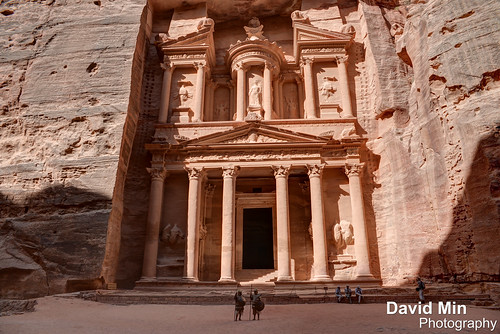Al Khazneh ("The Treasury") is one of the most elaborate temples in the ancient Jordanian city of Petra. As with most of the other buildings in this ancient town, including the Monastery (Ad Deir), this structure was carved out of a sandstone rock face. It has classical Greek-influenced architecture, and it is a popular tourist attraction.
Al Khazneh was originally built as a mausoleum and crypt at the beginning of the 1st Century AD during the reign of Aretas IV Philopatris. Its Arabic name Treasury derives from one legend that bandits or pirates hid their loot in a stone urn high on the second level. Significant damage from bullets can be seen on the urn. Local lore attributes this to Bedouins, who are said to have shot at the urn in hopes of breaking it open and spilling out the "treasure"—but the decorative urn is in fact solid sandstone). Another is that it functioned as a treasury of the Egyptian Pharaoh at the time of Moses.
Many of the building's architectural details have eroded away during the two thousand years since it was carved and sculpted from the cliff. The sculptures are thought to be those of various mythological figures associated with the afterlife. On top are figures of four eagles that would carry away the souls. The figures on the upper level are dancing Amazons with double-axes. The entrance is flanked by statues of the twins Castor and Pollux who lived partly on Olympus and partly in the underworld.
Monday, September 30, 2013
Petra, Jordan - Al Khazneh ("The Treasury")
Saturday, September 28, 2013
Madaba, Jordan - King Hussein Mosque
Madaba is the capital city of Madaba Governorate in central Jordan, which has a population of about 60,000. It is best known for its Byzantine and Umayyad mosaics, especially a large Byzantine-era mosaic map of The Holy Land. Madaba is located 30 kilometres south-west of the capital Amman.The first mosaics were discovered purely by chance during the building of the new permanent dwellings using squared-up stones from the old monuments.
The new inhabitants of Madaba, made conscious of the importance of the mosaics by their priests, made sure that they took care of and preserved all the mosaics that came to light.
The northern part of the city turned out to be the area containing the greatest concentration of mosaic monuments. During the Byzantine-Umayyad period, this northern area, crossed by a colonnaded Roman road, saw the building of the Church of the Map, the Hippolytus Mansion, the Church of the Virgin Mary, the Church of Prophet Elijah with its crypt, the Church of the Holy Martyrs (Al-Khadir), the Burnt Palace and the Church of the Sunna' family.
Wednesday, September 25, 2013
Petra, Jordan - Ad Deir ("The Monastery")
Petra is a historical and archaeological city in the southern Jordanian governorate of Ma'an, that is famous for its rock-cut architecture and water conduit system. Another name for Petra is the Rose City due to the color of the stone out of which it is carved.
Established possibly as early as 312 BCE as the capital city of the Nabataeans, it is a symbol of Jordan, as well as its most-visited tourist attraction. Petra has been a UNESCO World Heritage Site since 1985.
The site remained unknown to the Western world until 1812, when it was introduced by Swiss explorer Johann Ludwig Burckhardt. It was described as "a rose-red city half as old as time" in a Newdigate Prize-winning poem by John William Burgon. UNESCO has described it as "one of the most precious cultural properties of man's cultural heritage".
Ad Deir ("The Monastery") is a monumental building carved out of rock in the ancient Jordanian city of Petra. Built by the Nabataeans in the 1st century and measuring 50 metres wide by approximately 45 meters high, architecturally the Monastery is an example of the Nabatean Classical style. It is the second most visited building in Petra after Al Khazneh.
Sunday, September 8, 2013
Prague, Czech Republic - Old Town Plaza
Old Town is a medieval settlement of Prague, Czech Republic. It was separated from the outside by a semi-circular moat and wall, connected to the Vltava at both of its ends. The moat is now covered up by the streets Revolučni, Na Příkopě, and Národni—which remain the official boundary of the cadastral district of Old Town. It is now in Praha 1.
Soon after the city was expanded in the 14th century by Charles IV with the founding of the New Town, the moat and wall were dismantled.
Notable places in the Old Town include the Old New Synagogue, Old Town Square and Astronomical Clock. Across the river Vltava connected by the Charles Bridge is Malá Strana. Josefov is located in the northwest corner of Old Town heading towards the Vltava.
Sunday, September 1, 2013
Prague, Czech Republic - Prague Castle
Prague Castle is a castle in Prague where the Kings of Bohemia, Holy Roman Emperors and presidents of Czechoslovakia and the Czech Republic have had their offices. The Bohemian Crown Jewels are kept within a hidden room inside it.
The Guinness Book of Records lists Prague Castle as the largest ancient castle in the world. It occupies an area of almost 70 000 m², at about 570 metres in length and an average of about 130 metres wide. The castle buildings represent virtually every architectural style of the last millennium. The Prague Castle includes Gothic St Vitus Cathedral, Romanesque Basilica of St. George, a monastery and several palaces, gardens and defense towers. Most of the castle areas are open to tourists.




